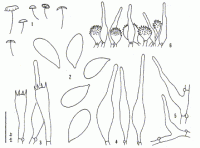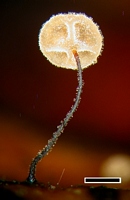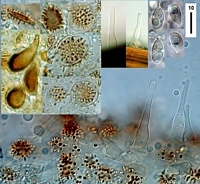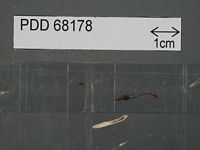|
 Marasmius rhopalostylidis Marasmius rhopalostylidis
BiostatusPresent in region - Indigenous. Endemic
Images (click to enlarge)
Caption: Fig. 9 (1-6). Marasmius rhopalostylidis Desjardin & E. Horak (PDD, holotype).- 1:
Basidiomes.- 2. Basidiospores.- 3. Basidia.- 4. Cheilocystidia.- 5. Caulocystidia.- 6. Pileipellis
(x500). | 
Caption: FUNNZ photo. scale=2mm
Owner: J.A. Cooper | 
Caption: upper left: cap cells. Middle top: caulocystidia. Upper right: spores. Lower cap cells and pilocystidia.
Owner: J.A. Cooper | 
Caption: Dried type specimen
Owner: Herb PDD | |
Article: Desjardin, D.E.; Horak, E. (1997). Marasmius and Gloiocephala in the South Pacific Region: Papua New Guinea, New Caledonia, and New Zealand taxa. Bibliotheca Mycologica 168: 152 p.
Description: Pileus 3-10 mm diam, hemispherical when young, expanding in age to convex with a subdepressed
disc, slightly plicate, tough, membranaceous; surface dull, dry, minutely pruinose overall (with hand
lens); pale beige-brown.- Lamellae shallowly adnate to subfree, distant to remote (5-8), often fold-like, narrow, lamellulae absent; concolorous with pileus.- Stipe 8-18 x 0.2-0.3 mm, central, equal,
cylindrical, wiry, minutely pruinose overall, insititious, erupting from black stroma-like spots up to
10 mm diam; apex white, black elsewhere.- Odor and taste not distinctive.
Basidiospores 9-11 x 4.5-5.5 µm, ellipsoid to broadly fusoid, smooth, thin-walled, hyaline,
inamyloid.- Basidia 25-35 x 7-9 µm, clavate, 4-spored, clamped.- Cheilocystidia 40-55 x 5-11 µm,
fusoid with elongated neck, hyaline, thin-walled.- Pleurocystidia absent.Pileipellis hymeniform,
composed of Rotalis-type cells interspersed with a few non-setulose cells and numerous
pileocystidia; Rotalis-type cells 15-24 x 10-20 µm, broadly clavate to subglobose, thin-walled,
apically thick-walled, hyaline to pale yellow-brown; divergent setulae 1-2 x 1 µm, cylindrical.Pi1eocystidia 35-50 x 6-10 µm, fusiform or ventricose with long neck, hyaline, thin-walled;
gloeocystidia absent.- Pileal and lamellar tissue inamyloid.- Stipe tissue monomitic; cortical hyphae
parallel, cylindrical, roughened, dextrinoid.- Cau1ocystidia scattered, 25-45 x 5-9 µm, polymorphic,
subacute, hyaline, thin-walled.- Clamp connections present.
Habitat: Habit, habitat and distribution.- Solitary, on rotting palm, fronds of Rhopalostylis sapida
(Palmae). New Zealand.
Notes: Marasmius rhopalostylidis forms small, beige pilei, well-developed distant lamellae, moderately
large basidiospores, pileo-, cheilo-, and caulocystidia that are fusiform to ventricose with a long-tapered, non-capitate apex, and sporulates on rotting palm fronds of Rhopalostylis sapida. It differs
from allied New Zealand taxa by the features presented in the key. It is similar to M. epiphylloides
from Europe, and M. munyozii Singer from Chile. Marasmius epiphylloides differs in forming
white pilei, poorly developed, intervenose lamellae, longer and narrower (11-17 x 2-4 µm),
cylindrical basidiospores, and basidiome formation restricted to leaves and twigs of Hedera helix.
Marasmius munyozii differs in forming more abundant lamellae (7-13), shorter and narrower
basidiospores (6-8 x 2-3 µm), filiform caulocystidia up to 165 mm long, and basidiome formation
on grass leaves (fide Singer, 1976).
|